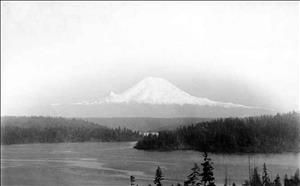On May 10, 1909, the Seattle City Council approves a request from the Board of Park Commissioners to initiate proceedings to acquire Bailey Peninsula – site of the future Seward Park – by condemnation. The city and the owners of the property had begun negotiating a sale in 1908 but had failed to reach agreement on the price. By condemning the property, the city exercised its right to claim ownership through the principle of eminent domain (the power of a government to acquire private property for public purposes), with the price to be determined by an independent, third-party appraiser.
Park in Waiting
William E. Bailey, a real estate investor from Pennsylvania, bought the peninsula that bore his name for $26,000 in 1889. The 277-acre property, jutting into Lake Washington opposite Mercer Island, was isolated and largely undeveloped. It included 120 acres of old growth forest. Limited access and the presence of poison oak had kept the loggers away. The peninsula was connected to the mainland by an isthmus that flooded seasonally, turning the little arm of land into an island. A handful of homesteads, established in the late 1850s, had been abandoned. Bailey looked at the peninsula and saw an investment. Superintendent of Public Parks Edward O. Schwagerl (1842-1910) looked at it and saw a park.
In 1892, Schwagerl proposed that the city sell what was then known as City Park (today’s Volunteer Park) and use the money to buy Bailey's peninsula and part of the shoreline instead. He developed a park plan centered on Fort Lawton and Alki Beach on the west side of the city, with Sand Point and a new "southeast park" on the east, all linked by bicycle paths. Many people complained that the peninsula was too far outside the existing city limits, but Schwagerl believed the area would soon be annexed. However, expansionist plans for both the city and its parks withered during the Panic of 1893 and the subsequent recession.
The gold rushes in Alaska and the Canadian Klondike in the late 1890s brought good times back to Seattle and led to renewed interest in parks. In 1903, the city hired the Olmsted Brothers of Brookline, Massachusetts – the most prestigious landscape architects in the country -- to design a comprehensive system of parks and parkways. "It was fashionable and au courant to have a park system," noted David Streatfield, a professor of landscape architecture history at the University of Washington. Even so, Seattle was dreaming big. "The scale of what was proposed at that time was ambitious and anticipated a huge explosion in population," Streatfield added (Seattle Post Intelligencer, 2003).
Resurrecting a Dream
The firm’s senior partner, John C. Olmsted, (1852-1920), took charge of Seattle’s plan. His first recommendation was that the city buy Bailey Peninsula. The peninsula was still outside the city limits (it would not be annexed until 1907), but like Schwagerl, Olmsted recognized its value as parkland.
The city council approved Olmsted’s plan on October 19, 1903. Bailey Peninsula was a key element. Olmsted envisioned it as the anchor of landscaped boulevard that would wind north along Lake Washington. However, it wasn’t until 1908 that the Bailey family agreed to sell the peninsula, and then at an asking price ($430,000) that was more than 16 times the $26,000 William E. Bailey had paid for it in 1889. The city rejected the offer as exorbitant.
The park board filed a request to condemn the land for the creation of a park on April 30, 1909. The city council approved the request on May 10 and ordered the city attorney to begin the proceedings. On June 20, 1910, the attorney reported that the appraiser had settled on a fair market value. Early the next year, the city paid the family $322,000 for Bailey's peninsula.
The new park was named in honor of William H. Seward (1801-1872), Secretary of State under President Andrew Johnson (1808-1875), who arranged for the purchase of Alaska in 1867. The Olmsted Brothers were awarded the contract to develop it, one of the 37 parks in Seattle that they designed. The plan, prepared in 1912, laid out the general concepts for the park that exists today: a mix of shoreline, meadows, picnic areas, and playfields, ringing what Olmsted called the "Magnificent Forest" -- the largest stand of native forest in the city.

